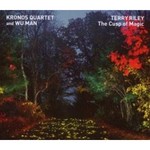
Terry Riley: The Cusp of Magic
 $35.99
Special Order
$35.99
Special Order3 - 6 weeks add to cart more by this artist
Kronos Quartet & Wu Man
Terry Riley: The Cusp of Magic
[ Nonesuch Records / CD ]
Release Date: Monday 21 April 2008
This item is only available to us via Special Order. We should be able to get it to you in 3 - 6 weeks from when you order it.
Peyote rituals, Chinese lullabies, Indian ragas, children's toys, sacred bonds, and secular madness all dance and swirl in ritualistic fashion in Terry Riley's extraordinary The Cusp of Magic.
Commissioned by the Kronos Quartet - with whom Riley has collaborated ever since he met its founder, David Harrington, while Riley was teaching at Mills College in the '70s - the work celebrates the composer's 70th birthday. The 43-minute quintet also draws upon the talents of another frequent Riley collaborator, pipa player Wu Man.
Some critics have suggested that The Cusp of Magic represents a new direction for the "father of Minimalism." But those who have followed Riley's path since his seminal In C changed the course of music history, see continuity. In C derived from a single page of 53 different repetitive patterns that came to Riley "as a kind of gift" one night in 1964 as he was riding the bus, stoned, to his night job playing ragtime, sing-along, and rinky-dink at San Francisco's Gold Coast Saloon.
Six years later, around the same time he met Harrington, Riley began studies with North Indian vocalist Pandit Pran Nath. As he continued his sacred excursions through music, celebrations of peace, space adventures, lives taken too soon, far-out jazz, and electronic soundscapes unfolded from his pen. The Cusp of Magic, a celebratory, pancultural, peyote ritual for the new century, thus represents a logical progression in this musical shaman's journey.
The six-part quintet's opening movement, "The Cusp of Magic" (listen online), is a rite of midsummer. (The title derives from the writings of Gary Goldschneider, to whom Riley dedicates the work.) In this 10-minute entry into the mystical, profound poundings on the bass drum, a repetitive rattle, the irregular meters of Native American song, and the murmurings of a synthesizer contrast with the sounds of string quartet and pipa. In two succeeding movements, "Buddha's Bedroom" and "The Nursery," the lovely, unaffected singing of Elisabeth Commanday (granddaughter of SFCV founder Robert Commanday - a coincidence that does not influence my commentary) soulfully intones lullabies by Wu Man and Riley. In addition to a wonderful pipa solo, we hear rattles, charms, whizzing sounds, strange laughter, and other surprises. Those who have journeyed will recognize the mixing of the sacred and the mundane in helter-skelter fashion.
A song meant to celebrate a wedding, written in the form of a North Indian gat, begins the fourth movement (aptly titled "Royal Wedding," listen online). The movement continues to build, with sonorous contributions from Kronos' latest cellist, Jeffrey Ziegler, creating passages of great rhythmic intensity.
The ear-catching fifth movement, "Emily and Alice," (listen online), employs the delightful sounds of toys belonging to Harrington's granddaughter Emily and Kronos manager Janet Cowperthwaite's daughter Alice. At one point, Tchaikovsky's Nutcracker makes an appearance, as does the tune of Russian cartoon character Cheburashka. Eventually the tone becomes somber, as Riley reflects on the life-threatening, global challenges of the world.
The ritual ends with the irresistible rhythms and colors of "Prayer Circle" (listen online). As the thin, slightly craggy sound of the pipa contrasts with the warmth of the string quartet (which sounds far more ingratiating on a good soundsystem than amplified in live performance), the work concludes with an ecstatic flourish. To my ears, the final notes proclaim "Yes!"
REVIEW IN SAN FRANCISCO CLASSICAL VOICE BY J.V. SERINUS
Tracks:
1. I. The Cusp of Magic 10:03
2. II. Buddha's Bedroom 10:28
3. III. The Nursery 5:03
4. IV. Royal Wedding 6:07
5. V. Emily and Alice 4:05
6. VI. Prayer Circle 6:41
